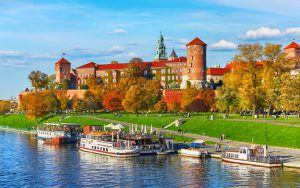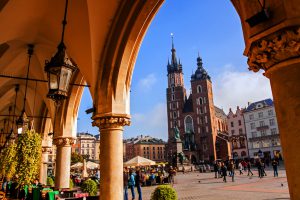Krakow, Poland
By Tracy A. Burns
An architectural wonder seeping with Polish history
 Krakow is an architectural wonder with Gothic, Renaissance and Baroque masterpieces. While in the cathedral, imagine all the coronations, royal funerals and weddings that took place there and pay your respects to the kings in the crypt. Feel the history of the Polish nation at Wawel Castle, for centuries the seat of kings. Become familiar with the superb Gothic artisanship of German sculptor Veit Stoss. Explore the churches. Visit the Kazimierz district’s Jewish quarter, where, for many centuries before World War II, Jewish culture thrived.
Krakow is an architectural wonder with Gothic, Renaissance and Baroque masterpieces. While in the cathedral, imagine all the coronations, royal funerals and weddings that took place there and pay your respects to the kings in the crypt. Feel the history of the Polish nation at Wawel Castle, for centuries the seat of kings. Become familiar with the superb Gothic artisanship of German sculptor Veit Stoss. Explore the churches. Visit the Kazimierz district’s Jewish quarter, where, for many centuries before World War II, Jewish culture thrived.
The beginnings of Krakow
Krakow was founded in the seventh century and, by the 10th century, was an important trading center. Around 1000, Polish kings began to reside there. Coronations took place on what is today known as the Royal Road – from St. Florian’s Church to Wawel Castle – as far back as the 14th century.
The Jagiellon Dynasty
The Jagiellon dynasty ruled from 1386 to 1572, an era when culture and art flourished. During the 14th century, what is now Jagiellonian University was established, making the town an academic hub.
After the Jagiellon Dynasty
When the last of the Jagiellon kings died, the capital was moved to Warsaw. During the 17th and 18th centuries, Krakow was a provincial town. In 1772 Austria took control of Galicia in southern Poland. During1815 the Republic of Krakow was established, but only lasted until 1846, when the Austrians took over again. By the end of the 19th century, Greater Krakow had come into existence. Artists frequented the many cafes and enjoyed the numerous cabarets.
Between the wars
All changed with World War I. After the war, Krakow became part of an independent Poland. For the first time in over 100 years, the city was not under foreign control. Between the wars, culture and institutions of higher learning thrived.
World War II
Then the Nazis took control. In September of 1939, Krakow became the headquarters for the Nazi General Government. At that time, about one quarter of the city’s population was Jewish. Museums, schools and theatres shut their doors. Jewish synagogues were destroyed. Jews, university professors, Roma and many others were sent to the gas chambers.
Under Communism
On January 18, 1945, the Soviets took control of the country from the Nazis, and Krakow was incorporated into the People’s Republic of Poland. Totalitarian oppression followed. In 1978, the Old Town was placed on the original UNESCO World Heritage Site list. That same year the Vatican elected a Polish pope, John Paul II. During the 1980s, the national Solidarity Union came into existence. With the country in economic straits, strikes followed. Communist authority waned.
As a democracy
In 1989 the Communist regime was toppled. Lech Walesa, a former electrician and leader of the Solidarity Movement, became president in 1990 and served a five-year term. In 1996 poet Wislawa Szymborska received the Nobel Prize for Literature. In 1999 Poland joined NATO. During 2004 the nation became a member of the European Union. It still has not adopted the Euro currency.
The cathedral
The cathedral and Wawel Castle are two of the city’s main attractions. Established in the 14th century, the cathedral was the setting for many coronations and historical events. The crypt includes tombs of kings and other prominent Poles. The interior styles run the gamut from medieval to modern. The relics of the patron saint of Poland, Saint Stanislaw, are on display here.
Wawel Castle
The Castle was transformed into a Renaissance structure in the 16th century. It features the Crown Treasury, Armory and staterooms. The 16th century tapestries, crown jewels and Oriental art are sure to amaze.
The Old Town
The Old Town revolves around the 13th century Main Market Square, one of the largest squares in Europe. In the summer it is bustling with outdoor cafes and street musicians. On the square is Cloth Hill, a Renaissance structure containing a lively market and a museum of 19th century Polish art. Climb Town Hall Tower for the views.
St. Mary’s Basilica
 One of the top attractions in the city, St. Mary’s Basilica features a triptych that is the largest Gothic altarpiece in the world, measuring 11 meters in length and 12 meters in height. It was made in the late 15th century by master sculptor Veit Stoss.
One of the top attractions in the city, St. Mary’s Basilica features a triptych that is the largest Gothic altarpiece in the world, measuring 11 meters in length and 12 meters in height. It was made in the late 15th century by master sculptor Veit Stoss.
Other churches
The Baroque Saints Peter and Paul Church is a masterpiece in every sense of the word. The stucco adornment and statuary are two highlights. The Church of St. Anne is another Baroque gem. If you are looking for Romanesque architecture, visit the Church of St. Andrew, which hails from the 11th century.
Museums
The National Museum in Krakow displays art from the Middle Ages to modern times. The renowned Princes Czartoryski Museum with its superb art collection is closed for renovation until at least 2019. The painting Lady with an Ermine by Leonardo da Vinci can be seen at Wawel Castle until April 30, 2017. From May 19, 2017, it will be displayed in the main hall of the Krakow National Museum. Other museums focus on Krakow’s history, natural history, and archeology.
Kazimierz Quarter
This area features the Jewish quarter. In the 15th century, Jews as well as Czech and German refugees settled here, and Kazimierz played a major role Jewish culture throughout Europe. The Nazis destroyed it, but some synagogues have been rebuilt and once again capture the spirit of the quarter. The Old Synagogue includes the Galicia Jewish Museum, which traces the history and culture of Jews in Krakow. About 700 graves have been unearthed in the Remu’h Cemetery, which was put to use in 1533 and destroyed by the Nazis. Do not miss a non-Jewish sight in this district – the crypt in the Church “On the Rock,” where national heroes are interred.
The Oskar Schindler Factory and the Ghetto Heroes Square
A must-see, the former Oskar Schindler enamel factory is now a museum focusing on the lives of Poles and Jews in Krakow during the Nazi Occupation. The factory was featured in Steven Spielberg’s 1993 film Schindler’s List, which described Schindler saving over 1,000 lives by employing Jews in his factory. The “Survivors’ Ark” consists of thousands of enameled pots. The museum brings to light everyday life for the inhabitants during the Nazi era and the stories of individual Jews. The Krakow Ghetto was established in March of 1941, and the memorial at The Ghetto Heroes Square consists of 33 steel and cast iron chairs and 37 smaller chairs on the edge of the square, where inhabitants wait for trams and buses. During World War II, people were transported to this square before being deported to concentration camps.
Jagiellonian University and other sights
Check out the oldest university in Poland, a school that Nicolaus Copernicus, King John III Sobieski and Pope John Paul II attended. There is a museum at the Collegium Maius. Visit the courtyard, and go on a tour. If the weather is cooperating, explore Planty Park or Jordan Park. Take a ride in a horse and carriage through the Old Town. Try one of the city’s famous bagels on Market Square. Whatever you decide to do, you will feel the history of the Polish nation and admire Polish art and culture.



